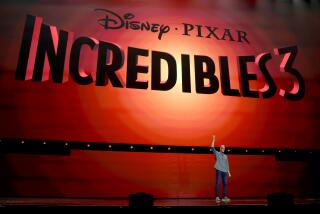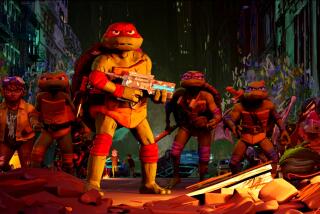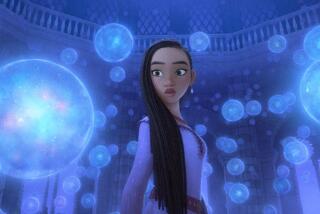Classic Hollywood: ‘101 Dalmatians’ was just the hit a flagging Disney needed
Walt Disney Studios was in a funk in 1959 after its expensive, lavishly animated fairy tale “Sleeping Beauty” didn’t awaken at the box office.
“Sleeping Beauty” had been a pet project of Walt Disney, who had mandated that the film “should look like a moving tapestry,” animator-director Frank Gladstone said. “It was heavily art-directed. The animation was so pristine and precise.”
Perhaps too precise. Though it received high marks for its visual style, “it didn’t carry the emotion people expected from a Disney film,” Gladstone added.
Veteran animator Floyd Norman, a young artist at Disney at the time, said the studio had serious concerns that animation might not be viable financially.
“We truly needed a hit,” he said. “We needed to come back strong.”
They did: “101 Dalmatians,” Norman said, was the film that “really kept animation alive at Walt Disney Studios.”
On Feb. 10, Disney will release its Diamond Edition of the 1961 classic on digital HD and Blu-ray as well as the Disney Movies Anywhere on-demand service. Extras include the new documentary “Lucky Dog,” featuring interviews with animators and talent involved in the film, and the new short “The Further Adventures of Thunderbolt.” Norman was involved in the writing and story boarding on the short.
He said the charming, vibrant “101 Dalmatians” was just the shot in the arm the studio needed.
“We had moved from a European fairly tale to a more contemporary story with a totally different sensibility,” Norman said. “It was fresh, it was bright.”
And it was made with half the staff employed for “Sleeping Beauty.”
“It was lean and mean,” Norman said. “We did it in half the time and half the cost.”
“Dalmatians” also used new Xerox technology. Animators still drew on paper, the same as they had on “Sleeping Beauty.” But whereas “Sleeping Beauty” drawings were hand-inked by hundreds of women in the ink and paint department, the arrival of Xerox meant that those drawings could be photocopied onto sheets of acetate, saving time and money.
With Xerox, Norman added, drawings could also be replicated. “We could take one puppy and duplicate that copy using the photocopy process, and make multiple puppies.”
Based on Dodie Smith’s book “The Hundred and One Dalmatians,” the box office hit revolves around Roger and his wife, Anita, and their Dalmatian dogs Pongo and Perdita. The family is looking forward to the birth of Perdita’s puppies. And so is Anita’s old girlfriend, Cruella De Vil, a whippet-thin villainous creature with skunk-striped hair who secretly wants the puppies to make coats of spotted fur.
“She was a wonderful villain — beautifully animated,” Gladstone said of Cruella.
“Even with little kids, they understood what she was trying to do, and they also understood she wasn’t going to win,” Gladstone said.
British actress Lisa Davis, the voice of the loving, concerned Anita, actually auditioned for the role of Cruella. Davis had appeared in the 1958 sci-fi cult film “Queen of Outer Space” with Zsa Zsa Gabor, and she could do a flawless impression of the Hungarian actress’ pronounced accent.
Disney, she said, was contemplating having Cruella sound like Zsa Zsa, so she was called in to audition with the man himself.
“He was reading the role of Anita, and I was struggling to do Cruella a la Zsa Zsa,” Davis said by phone. “As he was reading the part of Anita, I thought, ‘Oh, my gosh, I am much more suited to be Anita than I am Cruella.’ So I took a deep breath and interrupted him. It was a terrible dilemma. How do you tell Walt Disney he’s wrong?” (Betty Lou Gerson eventually got the role of Cruella.)
Once Davis got her part, Disney had her spend almost every day at a studio bungalow playing with Dalmatian puppies.
“What a wonderful job,” she said. “There I was, sitting on my bottom on the carpet surrounded by little puppies crawling all over me.”
Then-child actress Mimi Gibson was the voice of the adorable Lucky, the 15th pup who nearly died at birth. Lucky loves to watch television and delivers the classic lines: “I’m tired, and I’m hungry. And my tail’s froze. And my nose is froze. And my ears are froze. And my toes are froze.”
Gibson and the rest of the child performers had no idea what characters they were playing.
“They did all of our voices separately,” she said by phone. “Then, in the big puppy scenes, we would all be together.”
Gibson, who quit acting at age 20, acknowledged that “when you were a kid and working in the business, your dream was to get a Disney cartoon movie. There weren’t many parts for little girls. Then I got this and got to speak in a British accent. That was really fun.”
More to Read
Only good movies
Get the Indie Focus newsletter, Mark Olsen's weekly guide to the world of cinema.
You may occasionally receive promotional content from the Los Angeles Times.











